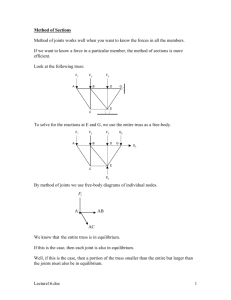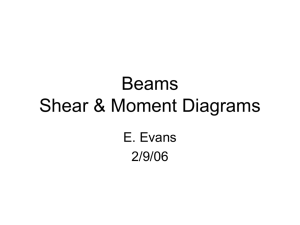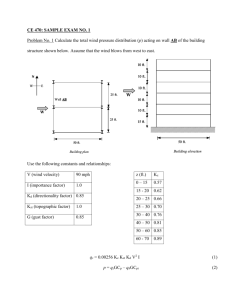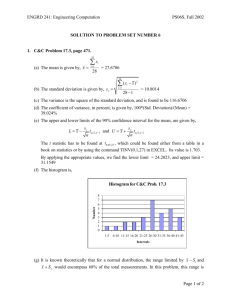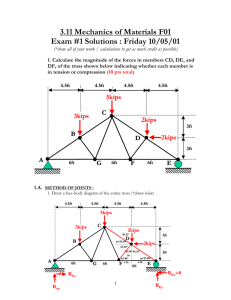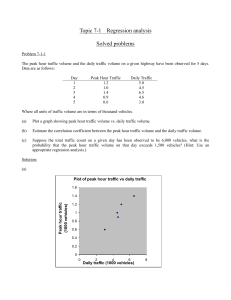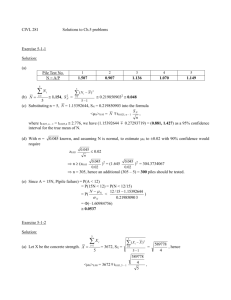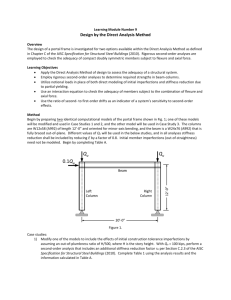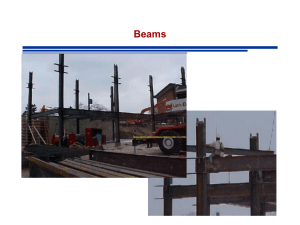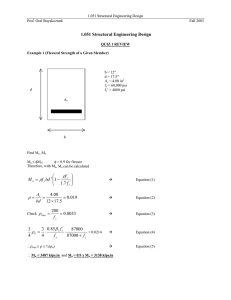Biaxial Bending
advertisement
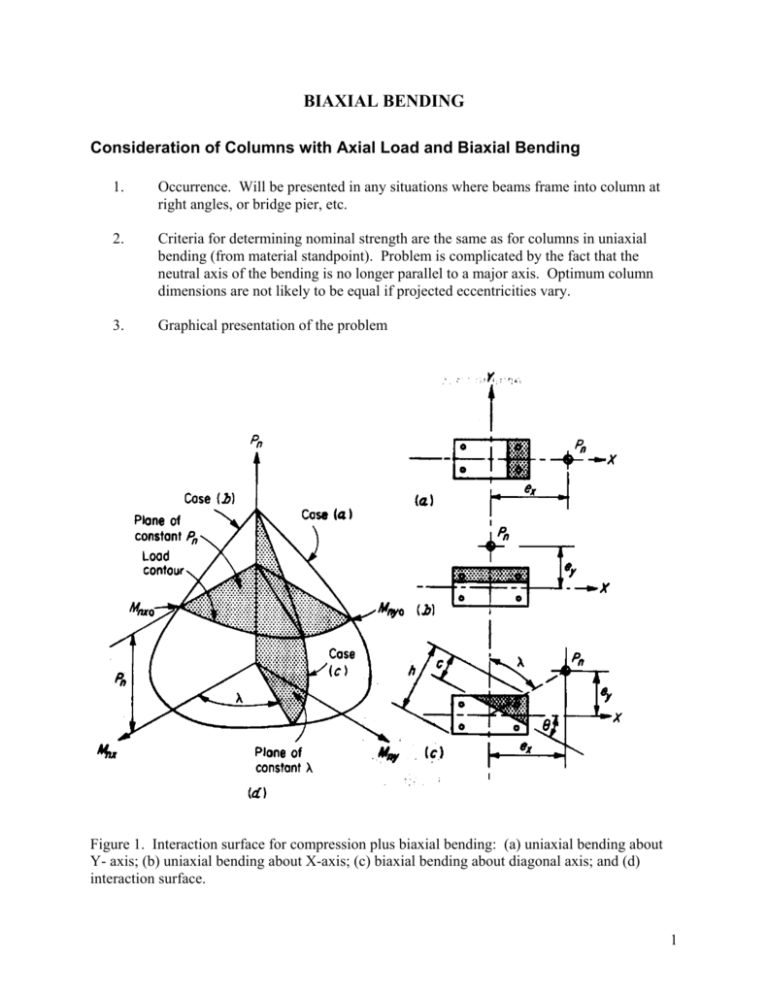
BIAXIAL BENDING Consideration of Columns with Axial Load and Biaxial Bending 1. Occurrence. Will be presented in any situations where beams frame into column at right angles, or bridge pier, etc. 2. Criteria for determining nominal strength are the same as for columns in uniaxial bending (from material standpoint). Problem is complicated by the fact that the neutral axis of the bending is no longer parallel to a major axis. Optimum column dimensions are not likely to be equal if projected eccentricities vary. 3. Graphical presentation of the problem Figure 1. Interaction surface for compression plus biaxial bending: (a) uniaxial bending about Y- axis; (b) uniaxial bending about X-axis; (c) biaxial bending about diagonal axis; and (d) interaction surface. 1 2 Current Methods of Analysis Bresler, B. “Design Criteria for Reinforced Concrete Columns Under Axial Load and Biaxial Loading.” Journal of the American Concrete Institute, Vol. 57, No. 5, November 1960, pp.481490. Bresler based his analysis on an assumption of a number of possible “Failure Surfcace” in three dimensions. Failure Surface 1 - Failure point defined as a function of axial load and eccentricities. Failure Surface 2 - Similar basis with 1 failure point defined as function of 1/ pn , ex , ey Bresler reasoned: 1. The failure surface is too complicated to exactly define. 2. An acceptable approximation could be defined by a plane which passes through three points which could be found by conventional (uniaxial bending) analysis. • 3 Reciprocal Load Mehtod Bresler’s reciprocal load equation derived from the geometry of the approximate plane: 1 1 1 1 = + − pn pnx 0 pny 0 p0 where pn = Approximate value of ultimate load in biaxial bending with eccentricity of ex , ey . pnx 0 = Ultimate load when only eccentricity e y is present ( ex = 0 ) pny 0 = Ultimate load when only eccentricity ex is present ( ey = 0 ) p0 = Ultimate load for concentrically loaded column. This procedure is acceptably accurate for design purposes provided pn ≥ 0.1P0 . If Pn < 0.1P0 , it would be more accurate to neglect the axial force entirely and to calculate the section for biaxial bending only. ACI strength reduction factors do not change the development in any fundamental way as long as the φ factor is constant for all columns. 1 1 1 1 = + − φ pn φ pnx 0 φ pny 0 φ p0 Note that: • It is necessary to use the uniaxial curves without the horizontal cutoff in obtaining values for the above equation. Tied Columns 0.8φ p0 • φ pn ≤ 0.85φ p0 Spiral Columns 4 Load Contour Method The load contour method is based on representing the failure surface of the Figure 1 give above by a family of curves corresponding to constant value of pn . The general form of these curves can be approximated by a non-dimensional interaction equation: α α2 1 M ny M nx = 1.0 + M 0 ny M nx 0 where: M nx = Pn ey M nx 0 = M nx when M ny = 0 M ny = Pn ex M ny 0 = M ny when M nx = 0 This equation gives the surface of design strength. The parameter alpha is 1.15 < α < 1.55 for square and rectangular columns where β is tabulated for specific • • • Strength Geometry Material strength 5 Design Example for Biaxial Bending ex = 6" 15” ey = 3" f c′ = 4 ksi Ast = 8 in 2 f y = 60 ksi 2.5” Pu = 275 kips 12” 2.5” Check the adequacy of the trial design (a) using the reciprocal load method (b) using load contour method 2.5” 2.5” (a) Using the reciprocal load method - Solution: About Y-axis 15 = 0.75 16 As 8 ρt = = = 0.033 Use Graph A.7 bh 240 e 6 = = 0.30 h 20 γ= Read from graph and simplify φ Pn A = 1.75 → φ Pn = 1.75 × 240 = 420 kips g φ Pn = 3.65 → φ P = 3.65 × 240 = 876 kips n Ag About X-axis 7 γ = = 0.58 say 0.6 12 6 7 = 0.58 12 As 8 = = 0.033 Use Graph A.6 ρt = bh 240 e 3 = = 0.25 h 12 γ= Read from graph and simplify φ Pn A = 1.8 → φ Pn = 1.8 × 240 = 432 kips g φ Pn = 3.65 → φ P = 3.65 × 240 = 876 kips n Ag The reciprocal method gives: 1 1 1 1 = + − φ pn φ pnx 0 φ pny 0 φ p0 1 1 1 1 = + − = 0.00356 φ pn 432 420 876 φ pn = 281 kips > Pu = 275 kips Therefore the design is adequate. 7 Using load contour method Solution About Y-axis Pu = φ Pn = 275 kips φ Pn 275 Use Graph A.7 = = 1.15 Ag 240 φ M nx 0 Ag h = 0.62 φ M nx 0 = 0.62 × 240 × 20 = 2980 in − kips About X-axis Pu = φ Pn = 275 kips φ Pn 275 Use Graph A.6 = = 1.15 Ag 240 φ M nx 0 Ag h = 0.53 φ M nx 0 = 0.53 × 240 × 12 = 1530 in − kips M uy = Pu ex = 275 × 6 = 1650 in − kips M ux = Pu ey = 275 × 3 = 825 in − kips The reciprocal method: α α2 1 M ny M nx = 1.0 + M M nx 0 ny 0 1.15 825 1530 1.15 1650 + 2980 = 0.491 + 0.507 = 0.998 < 1.000 This column is adequate. log 0.5 log 0.5 β = 0.56 → α = = 1.19 log β log 0.56 Note: Consider consider biaxial bending when estimated eccentricity ratio approaches or exceed 0.2. From Bresler α = 8 Design Example Problem: Select a tied column cross-section to resist factored loads and moments of Pu = 420 kips, Mux = 70 ft-kips, and Muy = 80 ft-kips. Use 8#8 bars in each face and No. 3 ties. f c′ = 4 ksi f y = 60 ksi Solution: 8 No. 8 bars → As = 8 × 0.79 = 6.32 in 2 Pu = 0.8φ 0.85 f c′Ac + As f y Pu = 0.8 × 0.65 0.85(4)( Ag − 6.32) + (6.32)(60) = 420 Solve for gross cross sectional area Ag = 132 in 2 Select: b = h = 11.45 → use b = h = 12 in Try a 12 inch by 12 inch column, use 1.5 inch cover, No. 3 ties, and assume No. 8 bars: 12 − 2(1.5 + 0.375 + 0.5) = 0.60 12 As 6.32 = = 0.044 ρt = bh 12 × 12 γ= M ux 70 × 12 = = 0.486 Pux Ag h 144 × 12 A = 2.4 ⇒ Pux = 2.4 × 144 = 345.6 kips g ρt = 0.044 Graph A.6 → φ P0 = 4.15 ⇒ P = 4.15 × 144 = 517.6 kips γ = 0.60 0 Ag 9 80 ×12 = 0.555 Puy Ag h 144 ×12 = 1.75 ⇒ Pux = 1.75 ×144 = 252 kips A g ρt = 0.044 Graph A.5 → φ P0 = 4.15 ⇒ P = 4.15 × 144 = 517.6 kips γ = 0.60 0 Ag M uy = The reciprocal method gives: 1 1 1 1 = + − φ pn φ pnx 0 φ pny 0 φ p0 1 1 1 1 = + − φ pn 345.6 252 597.6 φ pn = 195 kips < Pu = 420 kips ---- This column is not adequate. Try a 14 inch by 14 inch column, use 1.5 inch cover, No. 3 ties, and assume No. 8 bars: 14 − 2(1.5 + 0.375 + 0.5) = 0.66 14 As 6.32 ρt = = = 0.032 bh 14 × 14 γ= M ux 70 × 12 = = 0.3 Pux Ag h 14 × 14 ×14 A = 2.9 g ρt = 0.032 → Fig A.7 → φ P 0 = 3.6 γ = 0.66 γ = 0.75 Ag Pux = 2.84 → Pux = 2.84 × 14 ×14 = 557 kips Ag M ux 70 × 12 = = 0.3 Pux Ag h 14 × 14 ×14 A = 2.8 φ P0 = 3.6 → P = 3.6 × 14 × 14 = 713.4 kips ux g ρt = 0.032 Ag → Fig A.6 → φ P0 = 3.6 γ = 0.60 Ag 10 80 × 12 = 0.35 Pux Ag h 14 × 14 × 14 A = 2.75 g ρt = 0.032 → Fig A.7 → φ P0 = 3.6 γ = 0.75 γ = 0.66 Ag Pux = 2.69 → Pux = 2.69 × 14 × 14 = 528 kips Ag M uy 80 × 12 = = 0.35 Pux Ag h 14 × 14 × 14 A = 2.65 φ P0 = 3.6 → P = 3.6 × 14 × 14 = 713.4 kips ux g Ag ρt = 0.032 → Fig A.6 → φ P0 = 3.6 γ = 0.60 Ag M uy = The reciprocal method gives: 1 1 1 1 = + − φ pn φ pnx 0 φ pny 0 φ p0 1 1 1 1 = + − φ pn 557 528 717.4 φ pn = 435 kips > Pu = 420 kips ---- This column is adequate. Need to finish detailing 11
